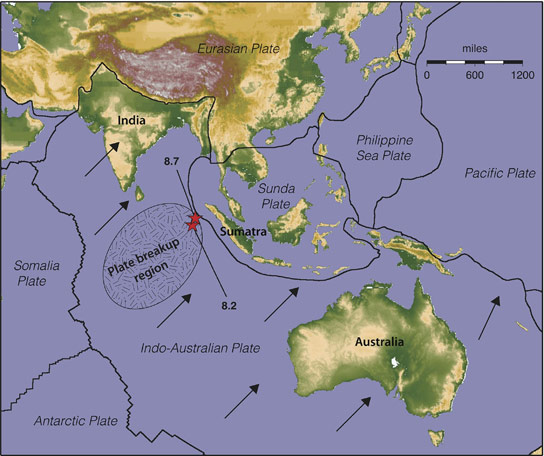
On April 11th, 2012 a pair of massive earthquakes rocked the Indian Ocean. Scientists think that these may be the latest step in the formation of a new plate boundary on Earth’s surface.
The scientists published their findings in the journal Nature. The geological stresses are rending the Indo-Australian plate apart, and this probably caused the 8.6 and 8.2 magnitude quakes that broke along numerous faults and unleashed aftershocks for six days. Seismologists have suspected since the 1980s that the Indo-Australian plate might break up, but the April 11th quakes represent the most spectacular example of this process in action.
The Indo-Australian plate began its formation about 10 million years ago. As it moved northwards, the region near India smashed into the Eurasian plate, thrusting the Himalayas upwards and slowing India down. The Australian portion forged ahead, creating twisting tensions that are currently splitting the plate apart in the Indian Ocean.
The presence of these seismic stresses was inferred by modeling the stress changes shortly before the 2012 earthquakes. The model showed that pent-up stress from the 9.1 tremor in 2004, which unleashed a massive tsunami across the Indian Ocean, and another quake in 2005 probably helped trigger this event.
Large earthquakes occur when two plates collide at their boundaries, and one slides underneath the other. When large portions of plates slip horizontally along a fault line, this results in smaller quakes.
Accumulated stresses spread over the plate’s interior, resulting in a complex fault pattern. Unlike other earthquakes that shake along a single fault, this one ruptured along four faults, one of which slipped by 20 to 30 meters (66 to 99 feet).
Scientists studying the after-effects of the giant tremor discovered that earthquakes of 5.5 magnitude occurred at five times their normal rates all over the world. Aftershocks are usually restricted to the immediate vicinity of the main shock.
References:
“April 2012 intra-oceanic seismicity off Sumatra boosted by the Banda-Aceh megathrust” by Matthias Delescluse, Nicolas Chamot-Rooke, Rodolphe Cattin, Luce Fleitout, Olga Trubienko and Christophe Vigny, 26 September 2012, Nature.
DOI: 10.1038/nature11520
“En échelon and orthogonal fault ruptures of the 11 April 2012 great intraplate earthquakes” by Han Yue, Thorne Lay and Keith D. Koper, 26 September 2012, Nature.
DOI: 10.1038/nature11492
“The 11 April 2012 east Indian Ocean earthquake triggered large aftershocks worldwide” by Fred F. Pollitz, Ross S. Stein, Volkan Sevilgen and Roland Bürgmann, 26 September 2012, Nature.
DOI: 10.1038/nature11504